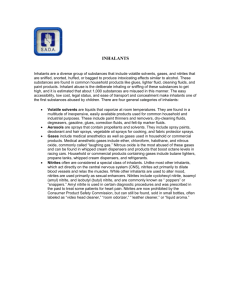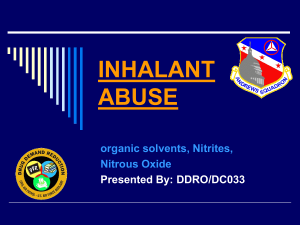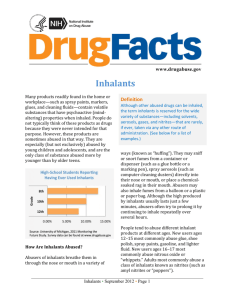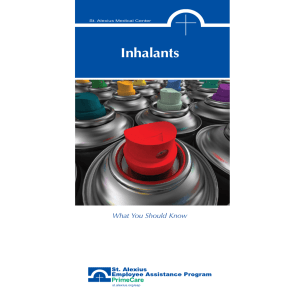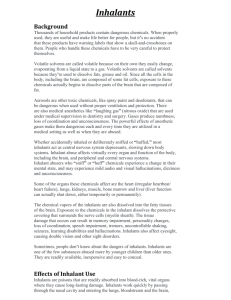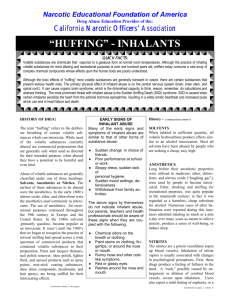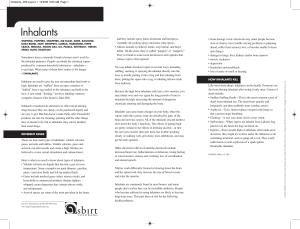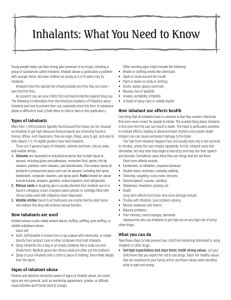Substance use, HIV and MARA A special focus: solvents, inhalants
advertisement
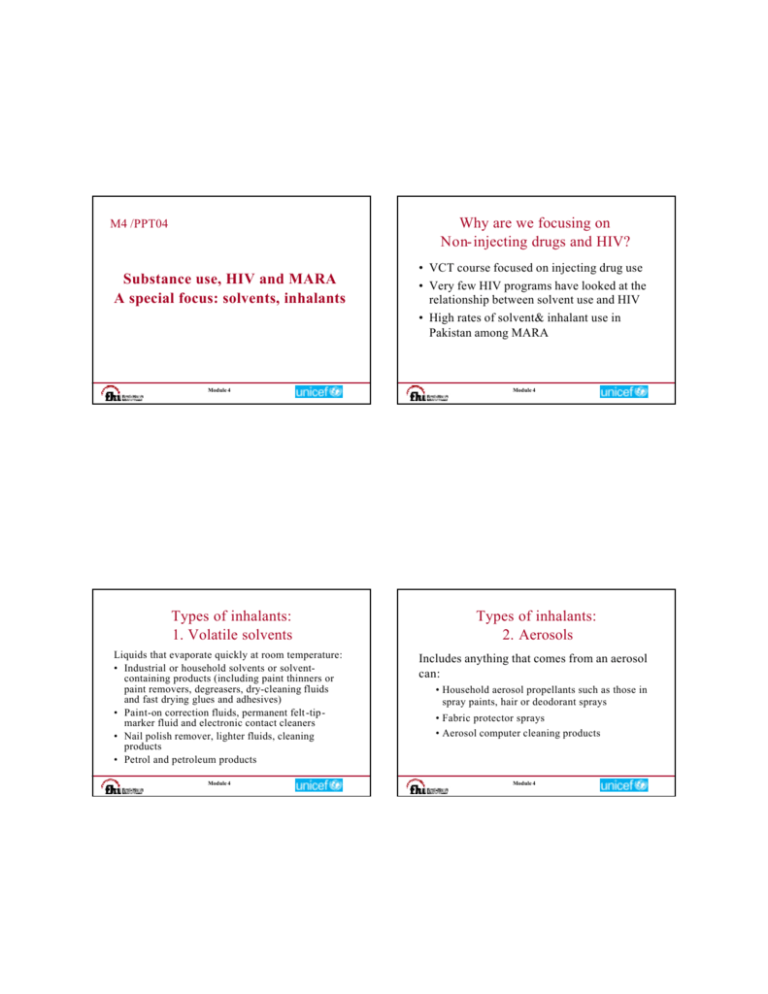
Why are we focusing on Non- injecting drugs and HIV? M4 /PPT04 Substance use, HIV and MARA A special focus: solvents, inhalants Module 4 Types of inhalants: 1. Volatile solvents Liquids that evaporate quickly at room temperature: • Industrial or household solvents or solventcontaining products (including paint thinners or paint removers, degreasers, dry-cleaning fluids and fast drying glues and adhesives) • Paint-on correction fluids, permanent felt -tip marker fluid and electronic contact cleaners • Nail polish remover, lighter fluids, cleaning products • Petrol and petroleum products Module 4 • VCT course focused on injecting drug use • Very few HIV programs have looked at the relationship between solvent use and HIV • High rates of solvent& inhalant use in Pakistan among MARA Module 4 Types of inhalants: 2. Aerosols Includes anything that comes from an aerosol can: • Household aerosol propellants such as those in spray paints, hair or deodorant sprays • Fabric protector sprays • Aerosol computer cleaning products Module 4 Types of inhalants: 3. Gases Types of inhalants: 4. Nitrates • Gases used in household or commercial products including butane lighters and propane tanks, whipped cream aerosols or dispensers and refrigerant gases • Medical anesthetic gases: ether, chloroform, halothane and nitrous oxide ("laughing gas") • Nitrites include nitrates or gases used in medical anesthesia or some household products • Helium, Freon (gas from air conditioners, refrigerators or other cooling equipment) • Volatile nitrites are often sold in small brown bottles and labeled as "video head cleaner," "room odorizer," "leather cleaner," or "liquid aroma" Module 4 South Asia & Pakistan • Manufactured superglues • Toluenes (in paint thinners) • Petrol • Iodex (muscle stress relieving balm) àYouth working in transportation centers such as bus or truck stands will have easy access to solvents, fuels and paints that can be inhaled. Module 4 • Amyl nitrite is a prescription drug to treat angina: nitrites are sealed in capsules and are "popped" to release the vapors and are referred to as "poppers" in street language Module 4 Activity 1 : large group • Local names and methods of use Module 4 • All inhalants are absorbed through the lungs and travel quickly in the blood to the brain. • This produces an immediate and brief intoxication. Module 4 How are these substances used? • Sniffed directly from an open container or inhaled from a rag soaked in the substance and held to the face • Open containers or soaked rags can be placed in a bag where the vapors can concentrate before being inhaled Module 4 How are these substances used? How are these substances used? • Users inhale vapors or aerosol propellant gases using plastic bags held over the mouth • By breathing from an open container of solvents, such as gasoline or paint thinner • Nitrous oxide gases from spray products (e.g.aerosol hairspray) are sprayed into plastic bags; some users may filter the aerosolized particles out with a rag. • Some gases such as propane and butane gases are inhaled directly from the canister. • Permanent drawing markers can be put into a plastic bag and then stepped on and crushed to breathe the vapors • Vapors from pocket lighters are inhaled through the nostrils Module 4 Module 4 Different types of inhalants produce different effects How do inhalants make you feel? • Inhaled solvents usually produce an alcohol-like effect, but with more distortion of perception (shape, size and color of objects) and distortion of time and space • Nitrous oxide produces a dreamy mental state, loss of motor control, hallucinations and an increased threshold for pain • Nitrites dilate blood vessels and relax muscles – New users may be initially excited, then become drowsy and fall asleep – People who use solvents more often may feel euphoric, exhilarated and have vivid fantasies – Some feel giddy, outgoing and confident – Physical effects may include dizziness, nausea, vomiting, blurred vision, sneezing and coughing, staggering, slow reflexes and sensitivity to light. Module 4 Use and long term effects • Serious health problems – People who use solvents regularly for a long time can damage their liver, kidneys, lungs, heart, brain, bones and blood – Sometimes this damage heals when drug use is stopped; sometimes it is permanent. Module 4 – Heartbeat quickens, blood rushes to the head, creating a "rush" • Nitrites also cause headaches, dizziness, nausea and flushing – Some men use nitrites during sex for the drugs' capacity to relax muscles and promote blood flow Module 4 Activity 1: Solvent abuse in Pakistan 1. Discuss the names and “nicknames” of solvents abused in different regions of Pakistan 2. Discuss the common signs and symptoms of their use (one by one) 3. Discuss how solvent use may be related to HIV transmission Module 4 Patterns of use are cues to • Social and recreational use as a means of enhancing social interaction or the enjoyment of some leisure activity • Symptomatic use as a means of reducing unpleasant sensations or experiences or to avoid challenging situations or responsibilities • Dependent use so that other responsibilities are neglected and harm may result. – – Such dependent use becomes habitual Abstinence may be associated with the onset of withdrawal symptoms and the discomfort of withdrawal will become a motivator for renewed drug use. Module 4 Long term use • Widespread and long-lasting damage to the brain and other parts of the nervous system • Memory impairment, attention deficits, and diminished non-verbal intelligence and even severe dementia • Extensive exposure to inhalants can also cause loss of feeling, vision and hearing and difficulties in coordination or limb spasms Module 4 What are the signs or symptoms or inhalant use? • • • • • • • • • Paint or stains on body or clothing Spots or sores around the mouth Red or runny nose Watery, red eyes Chemical breath odor Drunk, dazed or dizzy appearance Drowsiness or unconsciousness Nausea, loss of appetite Loss of interest in normal daily activities • • • • • • • Anxiety, excitability, irritability Inability to concentrate Substance odor on breath and clothes Poor muscle control Change in sleep patterns Prefers group activity to being alone Reduced attendance in school, Lower grades or poor attendance at or attention to work Module 4 Long term use • Sniffing glue and paint thinner causes kidney abnormalities • Sniffing the solvents toluene and trichloroethylene cause liver damage • Heart and lungs may also be affected • Some of the damage to the nervous and other organ systems may be at least partially reversible when inhalant abuse is stopped • But many of the problems are irreversible • Research indicates that inhaling nitrites depletes many cells in the immune system and impairs immune system mechanisms that fight infectious diseases – This has implications for HIV survival Module 4 Long term use “Sudden Sniffing Death" • Frequent or long-term use of nitrites can pose additional risks, including: • Prolonged inhaling of the highly concentrated chemicals in solvents or aerosol sprays can cause irregular and rapid heart rhythms à heart failure and death within minutes of a session of prolonged sniffing • Can result from a single session of inhalant use by an otherwise healthy young person • Particularly associated with the abuse of butane, propane, and chemicals in aerosols – Glaucoma leading to blindness. Nitrites increase pressure in the nerves and blood vessels in the eyes. – Blood Cell Damage. Nitrites damage red blood cells and may cause an often-fatal anemia in which blood can no longer transport oxygen. • This type of poisoning happens most often to users who swallow (rather than sniff) the chemical and it requires immediate medical treatment Module 4 Module 4 Inhalant abuse can also cause death by: Inhalant abuse can also cause death by: • • • • • • Asphyxiation Suffocation Convulsions or seizures Coma Choking Fatal injury - from accidents Source:http://www.nida.nih.gov/ResearchReports/Inhalants/Inhalan ts4.html • Spraying butane directly into the throat, the jet of fluid can cool rapidly to –20 °C by expansion, causing prolonged spasm of the larynx [throat] and suffocation. • The anesthetic gases present in the inhalants appear to sensitize the user to adrenaline. When intoxicated, a sudden surge of adrenaline (e.g., from a frightening hallucination or run-in with the law), can cause a fatal cardiac arrhythmia [disturbances regularity of heartbeat] • Actual overdose from the drug does occur, however, and indeed inhaled solvent abuse is statistically more likely to result in life -threatening respiratory depression than intravenous use of opiates such as heroin. Source:http://www.drugabuse.gov/pdf/monographs/148.pdf Module 4 Module 4 • Withdrawal symptoms Depending on the substance, these may include: • Anger, • Irritability, • Generalized aches and pains Module 4 Other problems • Poor nutrition due to nausea, loss of appetite • Young people may be using inhalants to overcome feelings of hunger when they can’t afford food. • In many settings it will be easy to have ‘free’ access to inhalants Module 4 Drug and alcohol interactions, including ARV • NO research specifically into ARV….but • Liver and kidney damage – inability to clear drugs normally, build up to toxicity • Confusion and intoxication – forgetting to take medications on schedule • Inhaling nitrites depletes many cells in the immune system and impairs immune system mechanisms that fight infectious diseases • Researchers believe that nitrites may impair immune response and contribute to the onset of secondary infections often seen in people with AIDS Module 4 Other problems • The methods of sharing do not pose any risk of blood-borne infection such as occurs through sharing injecting drug solutions and equipment • Individuals who abuse nitrites to enhance sexual function and pleasure à more likely to engage in unsafe sexual practices à greatly increase the risk of contracting and spreading such infectious diseases as HIV and AIDS and hepatitis Module 4 More danger • Particularly dangerous practices include: – Putting a plastic bag completely over the head – Spraying directly into the mouth – Having lighted cigarettes around due to risk of catching fire – Mixing volatile substances with other drugs/alcohol – Using alone Module 4 Help for Volatile Substance Abuse (VSA) rehabilitation • Unfortunately, few, if any, of the drug rehabilitation services in Pakistan deal with VSA • Programs in other countries often focus on life skills and anger management. Module 4 Activity 2: Patterns of use & Therapeutic cues • In your small groups • Discuss what questions you can ask a client to determine their pattern of use • Drawing on your professional background, discuss the different approaches for each described pattern giving explicit examples • Present your findings to the large group Module 4 Activity: Working in your groups • Review the “stages of change” model – previously discussed in the VCT Training course • A copy is appended in your Lecture Notes for this module Module 4
